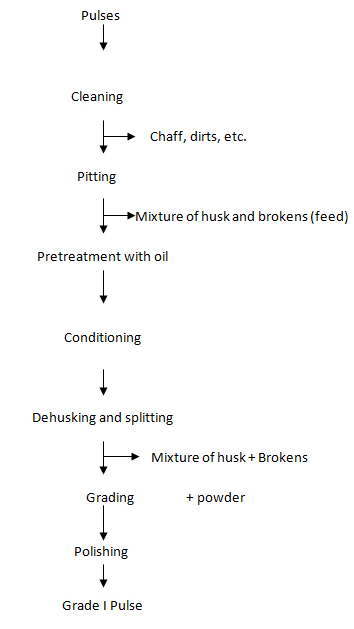Traditional dry milling method ('DHAL' MILLING) : There is no common processing method for all types of pulses. However, some general operations of dry milling method such as cleaning and grading, rolling or pitting, oiling, moistening, drying and milling have been described in subsequent paragraphs.
Cleaning and grading : Pulses are cleaned from dust, chaff, grits, etc., and graded according to size by a reel type or rotating sieve type cleaner.
Pitting : The clean pulses are passed through an emery roller machine. In this unit, husk is cracked and scratched. This is to facilitate the subsequent oil penetration process for the loosening of husk. The clearance between the emery roller and cage (housing) gradually narrows from inlet to outlet. As the material is passed through the narrowing clearance mainly cracking and scratching of husk takes place by friction between pulses and emery. Some of the pulses are dehusked and split during this operations which are then separated by sieving.
Pretreatments with oil : The scratched or pitted pulses are passed through a screw conveyor and mixed with some edible oil like linseed oil (1.5 to 2.5 kg/tonne of pulses). Then they are kept on the floor for about 12 hours for diffusion of the oil.
Conditioning of pulses : Conditioning of pulses is done by alternate wetting and drying. After sun drying for a certain period, 3-5 per cent moisture is added to the pulse and tempered for about eight flours and again dried in the sun. Addition of moisture to the pulses can be accomplished by allowing water to drop from an overhead tank on the pulses being passed through a screw conveyor. The whole process of alternate wetting and drying is continued for two to four days until all pulses are sufficiently conditioned. Pulses are finally dried to about 10 to 12 per cent moisture content.
Dehusking and Splitting : Emery rollers, known as Gota machine are used for the dehusking of conditioned pulses About 50 per cent pulses are dehusked in a single operation (in one pass). Dehusked pulses are split into two parts also, the husk is aspirated off and dehusked, split pulses are separated by sieving. The tail pulses and unsplit dehusked pulses are again conditioned and milled as above The whole process is repeated two to three times until the remaining- pulses are dehusked and split.
Polishing: Polish is given to the dehusked and split pulses by treating them with a small quantity of oil and / or water.
|

